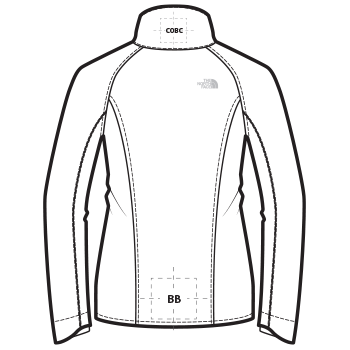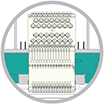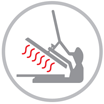


| Front Decoration Dimensions | |||
|---|---|---|---|
| COL | Collar Left | 2"H x 3"W | |
| COR | Collar Right | 2"H x 3"W | |
| FC | Full Chest | N/A | |
| LB | Left Bottom | 3"H x 3"W | |
| RB | Right Bottom | 3"H x 3"W | |
| RC | Right Chest | 4"H x 4"W | |
| Back Decoration Dimensions | |||
|---|---|---|---|
| BB | Back Bottom | 18"H x 8 | |
| COBC | Collar Back | 2"H x 4"W | |
| Sleeve Decoration Dimensions | |||
|---|---|---|---|
| FSL | Full Sleeve Left | 4"H x 20"W | |
| FSR | Full Sleeve Right | 4"H x 20"W | |
| LS | Left Shoulder | 4"H x 4"W | |
| RS | Right Shoulder | 4"H x 4"W | |
| RW | Right Wrist | 2"H x 2"W | |
| Hood Decoration Dimensions | |||
|---|---|---|---|
| BH | Back Hood | N/A | |
| FH | Front Hood | N/A | |
| IH | Inside Hood | N/A | |
| LHS | Left Hood Side | N/A | |
| RHS | Right Hood Side | N/A | |
Decoration TechniquesClick the icon for details
Essential Product Information
Due to the nature of 100% polyester fabrics, special care must be taken throughout the decoration process when heat is applied for curing. Please consult with your decorator or material supplier.
Due to the nature of water proof coatings, special care must be taken throughout the decoration process. An ink catalyst additive or special adhesive heat transfer is required. Please consult with your decorator or material supplier.
Tips From Our Experts By Decoration Technique
Embroidery is the art of embellishing a piece of apparel with a needle and thread or yarn creating stunning visual representations of various types of art. This is achieved by converting logos in a digitizing software and using various stitch patterns, angles, density and stitch types to create depth, movement and detail. Thread can be made from many materials. The most commonly used threads are polyester and rayon. There are also options such as metallic, cotton, nylon, silk and even Nomex thread for fire resistance. Embroidery has a very high-perceived value and is popular for use on most apparel, bags, hats, luggage, blankets and more!
An imprinting method in which the image is transferred to the fabric. Ink is squeegeed through a stenciled screen stretched over a frame and then cured in a dryer.
Low-cure poly inks are required. Grey or black bleed blockers may be necessary. Bonding catalysts may be required for stain release, water resistant/waterproof coated and nylon fabrics.A graphic, name and or number applied to a textile with a heat press. Great for quantities of any size, sports name and numbering, fashion, performance wear, print on demand programs and on-site decorating events.
Heat transfers with an aggressive adhesive are required for stain release, water resistant/waterproof coated and nylon fabrics. Consult with your transfer supplier for recommendations.Embossing uses a metal-engraved die along with a combination of time and temperature to create a design that will not fade or wash away. An embossed logo is made when the areas surrounding the logo are pressed, creating a puffed or raised look. This method works well on cotton, polyester, leather, pleather, fleece and polar fleece fabrics. It is an extremely upscale look and a fresh alternative to traditional decorating techniques.
*Darker colors and lighter weight garments may not give you the desired outcome.*,*Please consult with your decorator, equipment, and consumable supplier.*Laser etching is a decorating process that burns a pattern into the top layer of fabric, giving it a subtle tone-on-tone appearance. The image the etching creates has an upscale look that is usually the same color but several shades darker than the original fabric's color. It works well with both big or small logos.
*Test etch prior to production to dial in wattage and speed. Darker colors may not give you the desired outcome.*,*Please consult with your decorator, equipment, and consumable supplier.*specialty frames and applications that are specific to a shop's setup and equipment.




